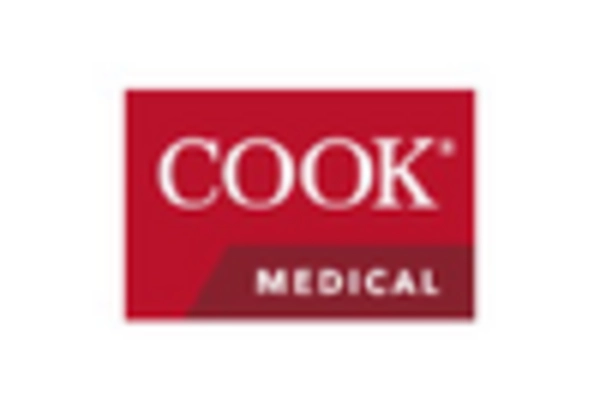Growing Aging Population
The demographic shift towards an aging population in the GCC is contributing to the growth of the biliary catheters market. As individuals age, the prevalence of biliary disorders tends to increase, necessitating the use of biliary catheters for effective management. By 2025, it is estimated that the proportion of the population aged 65 and above in the GCC will rise to 10%, leading to a higher demand for medical interventions. This demographic trend suggests that healthcare providers will increasingly rely on biliary catheters to address the needs of older patients. Consequently, the market is expected to witness a corresponding increase in the adoption of these devices, driven by the need for specialized care in managing biliary conditions among the elderly.
Increasing Healthcare Expenditure
The rising healthcare expenditure in the GCC region is a pivotal driver for the biliary catheters market. Governments and private sectors are investing significantly in healthcare infrastructure, which enhances the availability of advanced medical devices. In 2025, healthcare spending in the GCC is projected to reach approximately $100 billion, reflecting a growth rate of around 7% annually. This increase in funding allows for the procurement of innovative biliary catheters, improving patient outcomes and expanding treatment options. Furthermore, as healthcare facilities upgrade their equipment, the demand for high-quality biliary catheters is likely to surge, thereby propelling market growth. The emphasis on improving healthcare services and patient care quality in the region further supports the expansion of the biliary catheters market.
Advancements in Medical Technology
Technological innovations in the medical field are significantly influencing the biliary catheters market. The introduction of minimally invasive techniques and advanced materials has enhanced the efficacy and safety of biliary catheters. For instance, the development of biocompatible materials and improved catheter designs has led to reduced complications and increased patient comfort. In 2025, the market for advanced biliary catheters is anticipated to grow by approximately 15%, driven by these technological advancements. Furthermore, the integration of digital health solutions, such as remote monitoring and telemedicine, is likely to facilitate better patient management and follow-up care, thereby increasing the demand for sophisticated biliary catheters in the region.
Rising Awareness of Biliary Disorders
There is a growing awareness of biliary disorders among the population in the GCC, which is positively impacting the biliary catheters market. Educational campaigns and health initiatives aimed at informing the public about the symptoms and risks associated with biliary conditions are becoming more prevalent. This heightened awareness is likely to lead to earlier diagnosis and treatment, increasing the demand for biliary catheters. In 2025, it is projected that the number of diagnosed cases of biliary disorders will rise by 20%, further driving the need for effective management solutions. As healthcare providers respond to this demand, the biliary catheters market is expected to expand, reflecting the importance of education in improving health outcomes.
Regulatory Support for Medical Devices
Regulatory frameworks in the GCC are evolving to support the development and approval of medical devices, including biliary catheters. The establishment of streamlined processes for device registration and quality assurance is encouraging manufacturers to innovate and introduce new products to the market. In 2025, it is anticipated that the regulatory environment will become even more conducive to the growth of the biliary catheters market, with an expected increase in the number of approved devices by 30%. This regulatory support not only enhances market accessibility but also fosters competition among manufacturers, leading to improved product offerings and better patient care solutions in the region.

















Leave a Comment